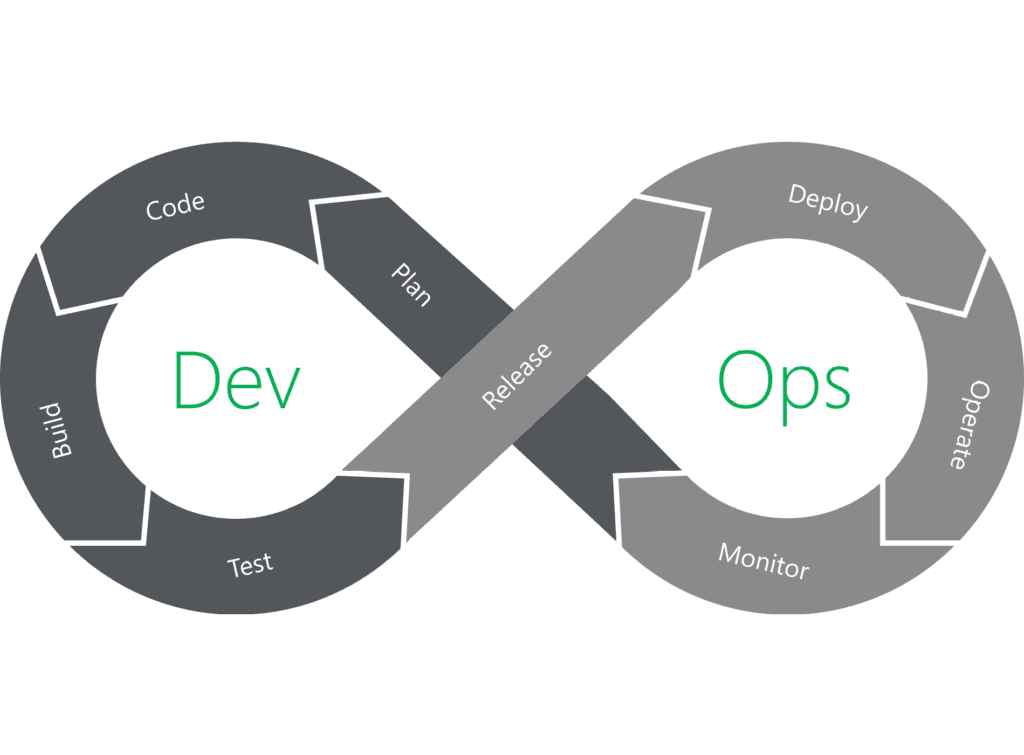How DevOps Infrastructure is Applied
Under a DevOps model, development and operations teams are typically consolidated into a single team where the engineers work across the entire application lifecycle, from development and test to deployment to operations, and develop a range of skills not limited to a single function. Similarly, quality assurance and security teams may also become more tightly integrated with development and operations throughout the application lifecycle. These concepts help to accelerate work and advance the overall velocity to reach the market.
Implementing the DevOps Cycle
DevOps best practices are arranged into a cycle of different phases that repeat as long as development for a certain project is allowed to continue. Typically, this is depicted as a figure eight with everything developmentally related on the left loop and the right loop focused on the operational side. Stage names or the number of stages can vary from interpretation to interpretation. Over the course of all phases, both teams are expected to work closely on maintaining goal alignment, quality, and work momentum.

Planning
DevOps teams have to adopt agile methodologies to work faster and provide better quality. Agility is an iterative process of project management and development that breaks tasks down into more manageable segments so goals are much more concrete. But do not forget this is supposed to be a team effort. Developers must workshop together to explore possible solutions, organize efforts, and prioritize objectives with the sole intention of delivering a good product. Everyone will need to be apprised of decisions made during this phase.
Coding and Building
By now, developers should have a good idea of what courses of action they need to take, either in the form of branching, merging, or rewriting existing code. Ideally, development teams should have a good control system and tools for establishing a solid workflow.
Testing
Continuous integration (CI) sees developers contributing to a single, shared repository. Quality assurance is necessary for ensuring any changes to the existing code will actually be effective and not cause any new problems to arise. Test as needed before rolling out.
Release and Deploy
The frequent automated release of features into production is referred to as continuous deployment (CD). Teams can deploy with feature flags, pushing out updates piecemeal rather than deploying all at once. While this feature might sound like it would slow production down significantly, the intention is to ensure the build is stable.
Operate
End-to-end delivery of IT services will still need manual oversight, including design, implementation, configuration, deployment, and maintenance. Some IT tasks can be automated with the right tools, but IT infrastructure will need to be supported to continue providing an organization’s services.
Observation and Customer Feedback
Remain vigilant in the case of failures or actions that have a high probability of risk. Systems can automatically notify the operations side of issues that can impede product uptime, speed, or function.
Customer responses are also a good indicator of the application’s performance in general. Whether it’s a bug that slipped past the testing phase, some design aspects are not as intuitive as developers assumed, or there is demand for a feature that has not been implemented yet, gathering these reports can help the team either incorporate such features or improve future deployments. Everything gathered during this phase will go into the planning phase of the next run.
DevOps Best Practices
CI/CD
Continuous integration and continuous delivery are fairly ubiquitous to DevOps. They refer to the practice of automatic code integration and automatically deploying code changes to testing and environments respectively. This is to help developers find bugs, build, and deploy much faster.
Monitoring and Awareness
Every member of the team needs to know everything that’s happening. Having necessary data helps everyone related to the project make better decisions in the long run, whether it be failures in deployment or testing, customer reactions, or spikes in application activity. The DevOps team should have the necessary DevOps monitoring tools to closely observe network metrics over the course of the life cycle. If visibility is a concern, check out our recommendations on how to make issues more visible.
Automation
Especially with cloud-based platforms with high-automation features such as AWS, automation is a great feature for DevOps practices because of how well it meshes with existing DevOps practices. Pushing code changes can trigger build, test, and deployment processes without needing to detract from other tasks developers need to perform.
Infrastructure as Code
Whether IT resources are allocated locally, in the cloud, or in a hybrid configuration, having the option to quickly provision, configure, and manage additional resources is essential for DevOps adoption. By treating infrastructure definitions as code, users can skip the need for configuring individual options or reviewing before deploying another instance by working from a template.
Microservices
Microservices are an architectural technique for building an application out of numerous smaller services that can still function independently of each other. Though each service can function independently, they still communicate with other services on the same interface.
Implementing New Practices
DevOps is going to be a necessary component of any development team. Even if it does mean significantly reorganizing company structure, start by slowly implementing base DevOps practices and concepts before restructuring team composition.
